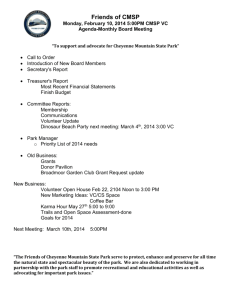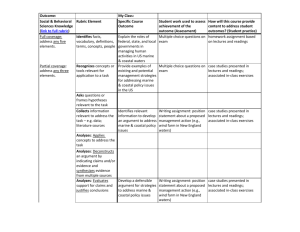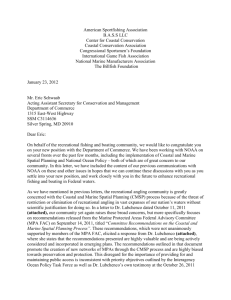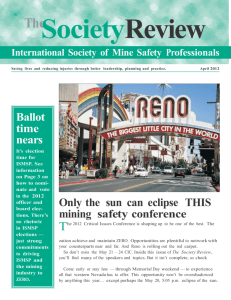View attachment - American Albacore Fishing Association
advertisement
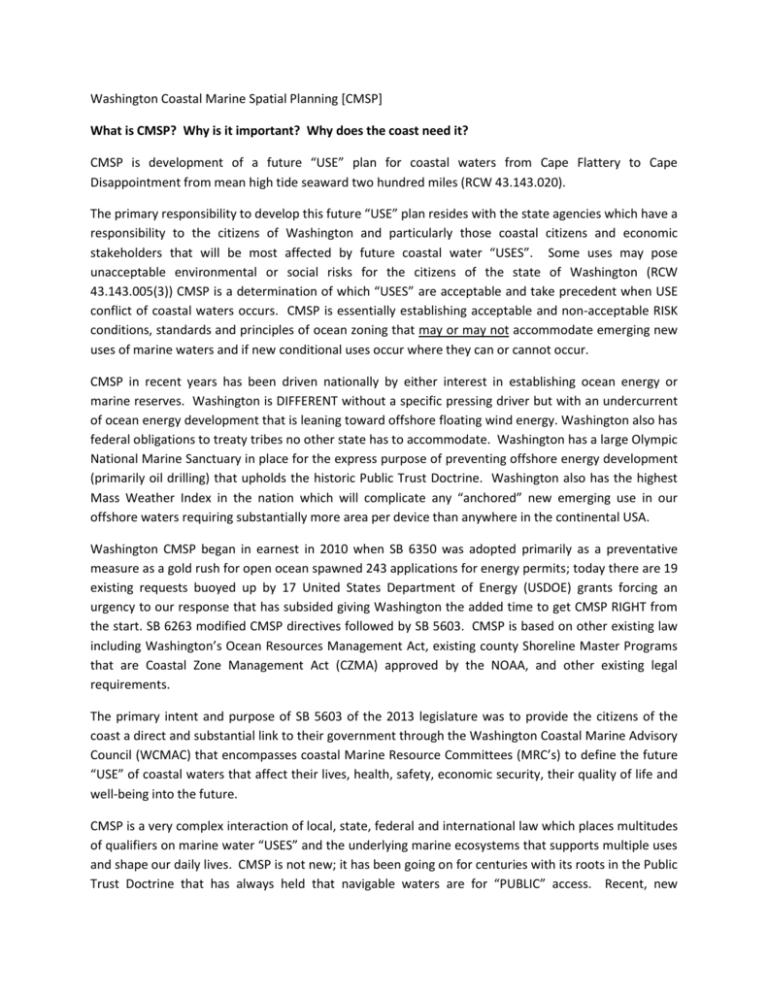
Washington Coastal Marine Spatial Planning [CMSP] What is CMSP? Why is it important? Why does the coast need it? CMSP is development of a future “USE” plan for coastal waters from Cape Flattery to Cape Disappointment from mean high tide seaward two hundred miles (RCW 43.143.020). The primary responsibility to develop this future “USE” plan resides with the state agencies which have a responsibility to the citizens of Washington and particularly those coastal citizens and economic stakeholders that will be most affected by future coastal water “USES”. Some uses may pose unacceptable environmental or social risks for the citizens of the state of Washington (RCW 43.143.005(3)) CMSP is a determination of which “USES” are acceptable and take precedent when USE conflict of coastal waters occurs. CMSP is essentially establishing acceptable and non-acceptable RISK conditions, standards and principles of ocean zoning that may or may not accommodate emerging new uses of marine waters and if new conditional uses occur where they can or cannot occur. CMSP in recent years has been driven nationally by either interest in establishing ocean energy or marine reserves. Washington is DIFFERENT without a specific pressing driver but with an undercurrent of ocean energy development that is leaning toward offshore floating wind energy. Washington also has federal obligations to treaty tribes no other state has to accommodate. Washington has a large Olympic National Marine Sanctuary in place for the express purpose of preventing offshore energy development (primarily oil drilling) that upholds the historic Public Trust Doctrine. Washington also has the highest Mass Weather Index in the nation which will complicate any “anchored” new emerging use in our offshore waters requiring substantially more area per device than anywhere in the continental USA. Washington CMSP began in earnest in 2010 when SB 6350 was adopted primarily as a preventative measure as a gold rush for open ocean spawned 243 applications for energy permits; today there are 19 existing requests buoyed up by 17 United States Department of Energy (USDOE) grants forcing an urgency to our response that has subsided giving Washington the added time to get CMSP RIGHT from the start. SB 6263 modified CMSP directives followed by SB 5603. CMSP is based on other existing law including Washington’s Ocean Resources Management Act, existing county Shoreline Master Programs that are Coastal Zone Management Act (CZMA) approved by the NOAA, and other existing legal requirements. The primary intent and purpose of SB 5603 of the 2013 legislature was to provide the citizens of the coast a direct and substantial link to their government through the Washington Coastal Marine Advisory Council (WCMAC) that encompasses coastal Marine Resource Committees (MRC’s) to define the future “USE” of coastal waters that affect their lives, health, safety, economic security, their quality of life and well-being into the future. CMSP is a very complex interaction of local, state, federal and international law which places multitudes of qualifiers on marine water “USES” and the underlying marine ecosystems that supports multiple uses and shape our daily lives. CMSP is not new; it has been going on for centuries with its roots in the Public Trust Doctrine that has always held that navigable waters are for “PUBLIC” access. Recent, new emerging uses seek to convert marine waters to restricted navigation areas (RNA’s). Washington CMSP law relies heavily on the historical Public Trust Doctrine that reserves rights to the states that embraces freedom of navigation, fishing, commerce, shellfish aquaculture, recreation, aesthetics, and qualifies new RNA standards and principles as acceptable if they do not cause harm or conflict with existing uses. CMSP is defining acceptable standards and principles associated with new use in marine waters and how Washington will interact with our federal partners on the Outer Continental Shelf (OCS) which is defined as the area from 3 – 200 miles offshore where the Bureau of Ocean Energy Management (BOEM) has primary responsibility to make energy leases (oil, gas, wind energy). Federal Energy Regulatory Commission (FERC) has primary responsibility to issue hydrokinetic permits (wave and tidal energy). The Coastal Zone Management Act (CZMA) administered by National Oceanographic & Atmospheric Administration (NOAA) is the local hook that requires all federal actions to be fully consistent with local and state law. On the Washington coast that is each counties Shoreline Master Programs (SMP’s). Washington Coastal Marine Spatial Planning will result in integrating the individual SMP’s which are currently under updating (2 – 4 year process) into the NOAA approved CZM program so that Washington and coastal counties can influence federal actions and future “USE” of coastal waters from Cape Flattery to Cape Disappointment from mean high tide seaward two hundred miles; this area encompasses all the estuaries; Grays Harbor, Willapa Bay, and the Columbia River.
